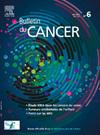SEPT2 provides new perspective for in-depth analysis of oncology
IF 0.8
4区 医学
Q4 ONCOLOGY
引用次数: 0
Abstract
Septins are a conserved family of GTP-binding proteins that assemble into cytoskeletal filaments to function in a highly sophisticated and physiologically regulated manner. Septins are highly conserved from yeast to humans and have gradually been accepted as a new class of cytoskeletal proteins. Mammalian septins have several functions in addition to their role in mitosis. They regulate cell polarity, cytoskeletal organization, vesicle trafficking, ciliogenesis and cell-pathogen interactions. At present, 13 septins have been identified from human. The human septins are classified into four groups based on sequence homology: SEPT2 (SEPT1, 2, 4, 5), SEPT3 (SEPT3, 9, 12), SEPT6 (SEPT6, 8, 10, 11, 14) and SEPT7 (SEPT7) groups. SEPT2, a member of the septin family, is involved in diverse cellular processes. These include the cell stiffness and plasma membrane rigidity observed in yeast, the chromosome segregation, microtubule regulation, and actin dynamics, and also the cytokinesis occurring in mammalian cells. SEPT2 plays a crucial role in tumorigenesis and tumor development. This review summarizes the current knowledge about the role of SEPT2 in tumors and supports its potential as a biomarker for certain types of tumors. After in-depth analysis, it provides new perspectives for oncology.
SEPT2为肿瘤学的深入分析提供了新的视角。
septin是一个保守的gtp结合蛋白家族,它们组装成细胞骨架细丝,以高度复杂和生理调节的方式发挥作用。从酵母到人类,septin是高度保守的,并逐渐被接受为一类新的细胞骨架蛋白。哺乳动物蛋白酶除了在有丝分裂中起作用外,还有其他一些功能。它们调节细胞极性、细胞骨架组织、囊泡运输、纤毛发生和细胞-病原体相互作用。目前,已从人体中鉴定出13种病毒。根据序列同源性将人类septin分为4组:SEPT2 (SEPT1, 2, 4, 5)、SEPT3 (SEPT3, 9, 12)、SEPT6 (SEPT6, 8, 10, 11, 14)和SEPT7 (SEPT7)。SEPT2是septin家族的一员,参与多种细胞过程。这些包括在酵母中观察到的细胞刚度和质膜刚度,染色体分离,微管调节和肌动蛋白动力学,以及哺乳动物细胞中发生的细胞质分裂。SEPT2在肿瘤发生和肿瘤发展中起着至关重要的作用。本文综述了目前关于SEPT2在肿瘤中的作用的知识,并支持其作为某些类型肿瘤的生物标志物的潜力。经过深入分析,为肿瘤学提供了新的视角。
本文章由计算机程序翻译,如有差异,请以英文原文为准。
求助全文
约1分钟内获得全文
求助全文
来源期刊

Bulletin Du Cancer
医学-肿瘤学
CiteScore
1.90
自引率
16.70%
发文量
224
审稿时长
37 days
期刊介绍:
Without doubt, the ''Bulletin du Cancer'' is the French language publication of reference in the field of cancerology. Official organ of the French Society of Cancer, this journal covers all the information available, whether in the form of original articles or review articles, but also clinical cases and letters to the editor, including various disciplines as onco-hematology, solids tumors, medical oncology, pharmacology, epidemiology, biology as well as fundamental research in cancerology. The journal proposes a clinical and therapeutic approach of high scientific standard and regular updates in knowledge are thus made possible. Articles can be submitted in French or English.
 求助内容:
求助内容: 应助结果提醒方式:
应助结果提醒方式:


